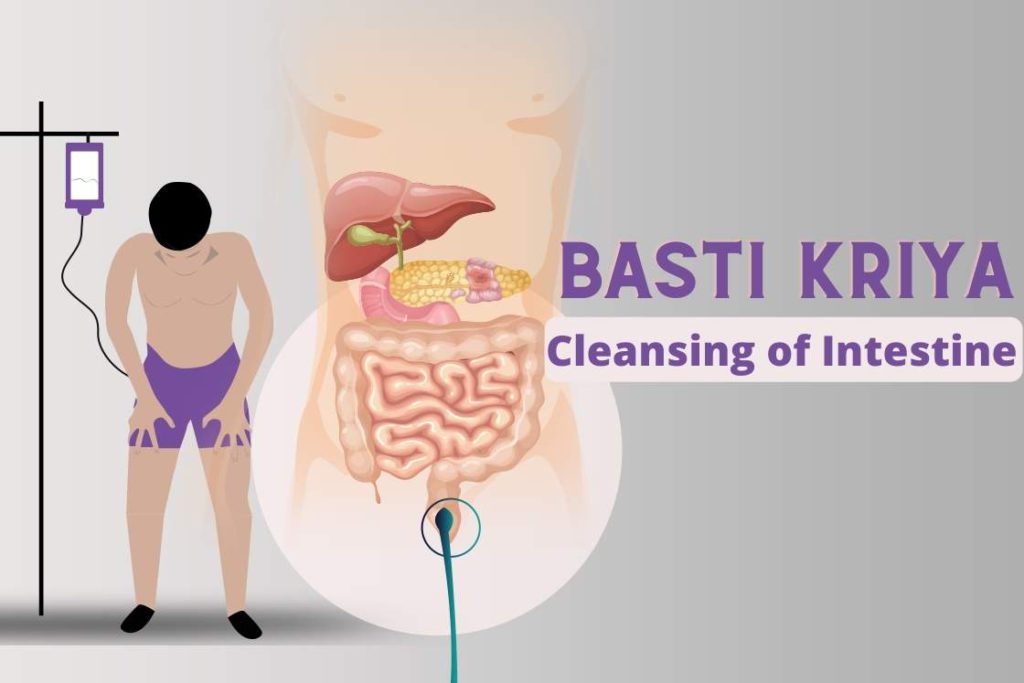
Basti Kriya is an internal cleansing technique that focuses on purifying the colon (large intestine). It is one of the six purification methods known as Shatkarma, described in the classical yogic text Hatha Yoga Pradipika.
According to the Hatha Yoga Pradipika, Shatkarma is a preparatory practice that helps cleanse the body from within, allowing the practitioner to progress smoothly towards higher yogic practices and spiritual goals.
Each Shatkarma technique targets a specific part of the body. In the case of Basti Kriya, it cleanses the lower abdomen by drawing in water or air through the anus to flush out toxins from the colon.
There are two main methods of performing Basti Kriya, both aimed at purifying the body from the inside. These practices help prepare the body for pranayama (breathing techniques) and more other advanced asanas.
Let’s now explore Basti Kriya in more detail, focusing on its meaning, methods, and benefits.
Basti Kriya Meaning
The word “Basti” refers to something that resides inside a cavity or enclosed space, and it can also mean “to hold” or even refer to the urinary bladder in some contexts.
Basti Kriya is similar to the Ayurvedic practice of an enema, where fluids are introduced into the rectum to clean the colon. In both cases, the main goal is to remove waste and toxins from the large intestine. Because of this similarity, Basti Kriya is often called the yogic enema.
In the Hatha Yoga Pradipika, Basti is described as:
“Sitting in utkatasana, navel deep in water, insert a tube into the anus and contract the anus. This cleansing with water is called basti karma.“
This cleansing technique is beneficial in curing several digestive, urinary, and eliminating disorders like flatulence, etc.
Basti Kriya Procedure
There are two types of performing Basti kriya, i.e. Jala Basti (with water) and Sthal Basti Kriya (with air). Let’s get into their practice one-by-one:
1. Jala Basti
Traditionally, jala basti was practiced squatting in a river, however, using a bucket or tub filled with water will do. “Jala” is a term denoting “water”, since the water is used to cleanse the bowels here, hence the name.
- Take a tub filled with water and sit or squat over it in utkatasana. The level of water must come up to the navel.
- Lean forward resting your hands on the knees.
- Suck the water into the large intestine via anus by expanding the anal sphincter muscles.
- Exhale and perform uddhiyana bandha and nauli kriya simultaneously. This will create a vacuum-like suction to draw the water into the lower abdomen and abdominal muscles undergo contraction and churning motion.
- Stand up holding the water inside the bowel for 5-30 minutes
- Then, exhale and expel the water out through the anus. This is the completion of the first round, you can repeat it for 3-5 rounds until the bowels are cleansed.
Tips to Ease the Jala Basti Kriya
- It is an advanced technique therefore beginners insert a catheter into the rectum for drawing the water in. Traditionally, people used to prefer bamboo tubes over plastic tubes or catheters.
- The catheter has to be at least 13-15 cm long, perfectly smooth, and hollow.
- About 4cm or above of the catheter is inserted into the anus. It is suggested to lubricate it with beeswax or non-irritating oil, viz. Vaseline or ghee for easy insertion.
- It is crucial to remove the catheter from the anus without exhaling as soon as you reach your limit of kumbhaka (breath retention).
- In the advanced stages where the tube is not required the rectum is pushed out opening the sphincter muscles with fingers. It is then drawn in performing uddhiyana bandha then the hand is removed followed by retention of breath and then exhalation.
- When you are prepared to expel the water out from the anus, always squat over the toilet as the stool will also be evacuated from the lower intestine.
- Ensure that the water is completely removed from the bowels.
Follow-up Practice (After Jala Basti Kriya)
- Lie down in shavasana on a blanket then gradually assume pashinee mudra. This helps in evacuating any retained water in the bowels via releasing air.
- Then again assume the shavasana followed by bringing the knees to the chest and rocking side to side on the floor. Alternatively, you can rock side to side by opening the arms on the shoulder level.
- Again rest in shavasana for a while and then practice bhujangasana 3-5 times to expel any remaining water or air.
- Also, you can add mayurasana to the sequence for better experiences.
2. Sthala Basti
- Lie down on your back at a 60-degree angle to the floor assuming viparita karani mudra.
- Now, draw the knees down towards the chest and push the sphincter muscles out and in to fill in the air into the bowels.
- The sucked-in air is held inside and pulled upwards towards the colon performing nauli kriya. Meanwhile, the air (Apana Vayu) rises upward exerting pressure on the navel region.
- Retain the air inside for a few minutes and then expel it through the anus.
- It forms one round of sthala basti and can be repeated 3-5 times as per convenience.
Sthala Basti Variations
Some texts also mentioned that sthala basti can also be practiced assuming pashinee mudra. Advanced practitioners also perform it holding paschimottanasana for 2-3 minutes along with practicing ashwini mudra 20-25 times.
In the beginning, while performing nauli kriya, uddhiyana bandha can also be applied, similar to jala basti, to suck the air in.
“Sthala” means “ground”, since this basti kriya is performed in the ground, therefore named so. People also refer to it as Pavana Basti or Vata Basti kriya because air is used for cleansing the colon.
Keeping in mind that the air used here is dry, sometimes it is also known by the name of Shushka Basti.
Basti Kriya Precautions
To ensure safety and effectiveness, keep the following precautions in mind before practising Basti Kriya:
- Avoid this practice if you have high blood pressure, hernia, or any serious digestive disorder.
- Do not eat anything for at least 72 minutes after performing Basti Kriya to allow the body to settle.
- Make sure you are already experienced in Nauli Kriya and Uddiyana Bandha before attempting Basti.
- For Jala Basti (water-based Basti), always use a sterilized catheter and ensure the water is clean, not too hot, and not too cold.
- Do not practise Basti Kriya during cloudy, rainy, windy, or stormy weather.
- Always perform this kriya early in the morning on an empty stomach for best results.
Basti Kriya Benefits
Basti Kriya offers a wide range of physical and energetic benefits by deeply cleansing the colon and lower abdomen. This ancient yogic practice plays a key role in detoxifying the body, supporting digestive health, and balancing the doshas. Regular practice of Basti Kriya enhances internal purification, strengthens abdominal organs, and improves overall well-being. Below are the key benefits of Basti Kriya:
1. Replenishes the bowels
Basti Kriya helps cleanse the entire colon by flushing out toxins, harmful bacteria, threadworms, excess heat, and accumulated waste. It purifies the lower intestines an area not easily cleansed through regular bowel movements. This makes Basti a powerful technique for detoxification and natural weight loss support.
2. Cures digestive disorders
Basti kriya practice benefits the abdominal organs, as pressure is exerted on the stomach. It stimulates the digestive organs and improves the efficiency of the digestive system.
Besides facilitating improved digestion, it cures digestive disorders. People suffering from constipation, nervous diarrhea, flatulence, and irritable bowel syndrome gets therapeutic benefits from Basti kriya. It also comes in handy while treating chronic colitis and dysentery with the doctor’s consent.
3. Balances the doshas
According to Ayurveda, an imbalance in the doshas causes disease. Basti Kriya helps remove excess Vata, Pitta, and Kapha doshas from the body. It purifies the internal organs, balances the tissues (dhatus), and promotes harmony in body functions. This balance improves energy flow and enhances overall vitality.
4. Enhances skin tone
By cleansing the colon and improving digestion, Basti Kriya supports better nutrient absorption, which leads to improved skin health. It hydrates the body from within, which enhances the glow, tone, and texture of the skin. A healthy digestive system reflects externally in the form of clearer, radiant skin.
5. Stimulates solar plexus
This yogic practice exerts pressure on the abdomen which stimulates and strengthens the solar plexus. It improves the overall well being of the body by influencing the nervous system. It enables the efficient working of the stomach, kidneys, liver, and adrenal glands.
6. Acts as a remedial practice
Diseases like Splenomegaly (spleen enlargement), dysuria (urinary disorders), colon cancer or tumors which is very common in male can be cured by performing basti kriya.
Conclusion
Basti Kriya is an advanced yogic cleansing of the body that cures most ailments. Its significance can be well understood by its description as “Ardha chikitsa“, i.e. half of all treatments of the world put together.
Thus, prepare your body physically, mentally, and spiritually for the advanced yogic practices along with revitalizing all your senses performing basti kriya.
Basti Kriya FAQs
1. What is the difference between Ayurvedic Basti and Yogic Basti Kriya
Ayurvedic Basti uses herbal enemas for detox and dosha balance, while Yogic Basti Kriya uses water or air for colon cleansing through yogic techniques.
2. Does Basti Kriya help with weight loss
Yes, Basti Kriya supports weight loss by removing waste, reducing bloating, and improving digestion and metabolism.
3. Is Basti Kriya effective for IBS
Yes, Basti Kriya can relieve IBS symptoms by regulating bowel movements, easing bloating, and calming the digestive system.
4. What is Sthala Basti or dry Basti Kriya
Sthala Basti is a dry version of Basti Kriya that uses air instead of water, performed through abdominal suction using Nauli and Uddiyana Bandha.
5. Can Basti Kriya cure colon cancer
No, Basti Kriya cannot cure colon cancer. It may support colon health but should not replace medical treatment.
6. What is the best time to do Basti Kriya
Basti Kriya should be done early in the morning on an empty stomach after natural bowel movement.
7. What are the signs Basti Kriya is working
You may feel a clean abdomen, lighter body, better digestion, reduced bloating, and improved energy levels.
8. What preparation is needed for Basti Kriya
Learn Nauli Kriya and Uddiyana Bandha first. Use clean lukewarm water, a sterilised catheter, and practise on an empty stomach.
9. Can Basti Kriya be done daily
No, Basti Kriya should not be done daily. Once a week or less is ideal to avoid over-cleansing the colon.
10. Who should avoid Basti Kriya
Avoid Basti Kriya if you have high blood pressure, hernia, ulcers, or during menstruation, pregnancy, or post-surgery recovery.




